Veg Hakka Noodles is one of the most loved Indo-Chinese dishes, commonly found on restaurant menus and street food stalls across India. The best part? This tasty dish can be effortlessly prepared at home with simple ingredients and a quick stir-fry.
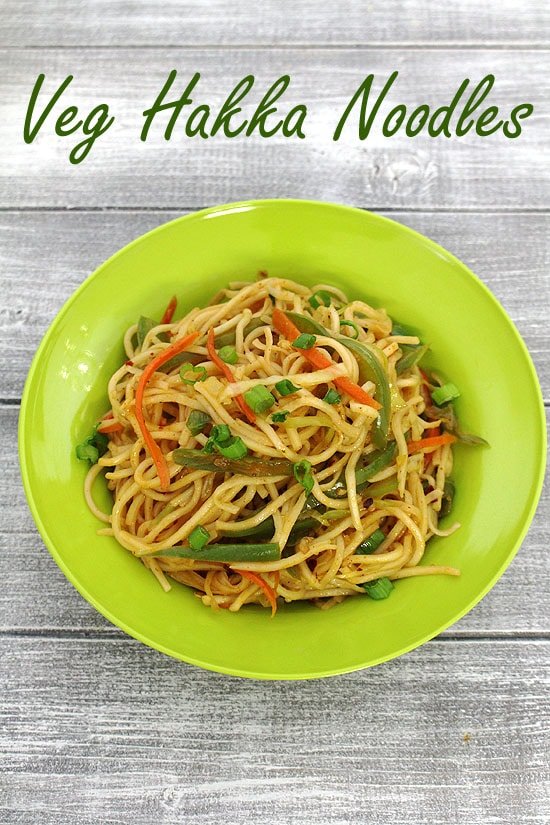
To get that authentic taste and texture, it’s important to stir-fry the vegetables on medium to high heat. To keep the vegetables crisp and vibrant, cook them only for a few minutes over high heat—just enough to soften slightly without losing their crunch.
You can easily adapt the vegetable mix to suit your taste. For this version, I’ve gone with a vibrant combination of capsicum, cabbage, carrots, beans, and onions.
The final color of your noodles will largely depend on the type and brand of chili sauce you choose, so go with one that suits your taste and spice level.
Like many Indo-Chinese recipes, Veg Hakka Noodles is easy to make. Most of the effort goes into the preparation, like chopping veggies, cooking the noodles, and getting the sauces ready. But once everything is prepped, the actual cooking takes just around 10 minutes!
Ingredients For Hakka Noodles:
- 150 grams of Hakka Noodles – Choose firm, non-sticky noodles designed for stir-frying to get the ideal texture and bite.
- 4–5 cups Water – To boil the noodles until just tender.
- 2 tablespoons Sesame oil – Adds authentic flavor and helps prevent noodles from sticking.
- 1 teaspoon Finely Chopped Ginger – Brings a bright, pungent flavor that enhances the overall aroma and warmth of the dish.
- 2 teaspoons Garlic, finely chopped – Adds depth and aroma.
- 2 teaspoons Celery, finely chopped – Optional, but gives a nice Indo-Chinese touch.
- ½ cup Capsicum, thinly sliced – Use green or colored peppers for crunch and sweetness.
- 1 cup Carrots, julienned – Adds color and a gentle bite.
- ½ cup Cabbage, shredded – Offers texture and volume.
- ¼ cup Green beans, thinly sliced diagonally – Tender-crisp and fresh.
- ½ cup Spring onion whites, sliced diagonally – For a mild, crisp onion flavor.
- 1 tablespoon Soy sauce – Brings in savory umami notes.
- 1 tablespoon Red chili sauce – Adjust for desired heat and flavor.
- Salt, to taste – Add carefully, keeping sauces in mind.
- ¼ teaspoon Black pepper powder – For a warm, spicy kick.
- ¼ teaspoon Red chili flakes – Optional, for extra spice and texture.
- 2 tablespoons Spring onion greens, chopped – Garnish for freshness and color.
- 1 teaspoon White Vinegar – Adds a subtle tanginess that balances the bold flavors of the noodles.
Step-by-Step Instructions:
1) Boil the Noodles
Bring 4–5 cups of water to a rapid boil in a large pot. Once boiling, add the hakka noodles and cook them as per the package instructions, or until they are just cooked—firm to the bite and not mushy.
2) Drain and Cool the Noodles
As soon as the noodles are cooked, strain them and rinse thoroughly under cold water to stop further cooking and prevent stickiness. This halts the cooking process and keeps the noodles from becoming sticky. Drizzle a teaspoon of oil over the noodles and gently toss to coat. Set aside.
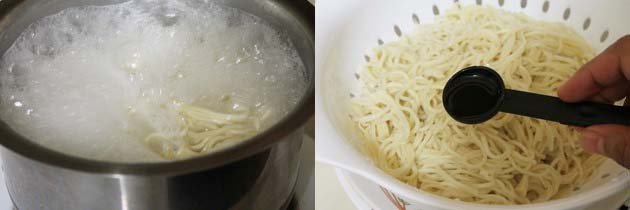
3) Chop the Vegetables
While the noodles are cooling, prepare and slice all your vegetables. Cut them thinly and evenly so they cook quickly during stir-frying.
4) Sauté Aromatics
Heat sesame oil in a wok or deep pan over medium-high heat. Once hot, add finely chopped ginger, garlic, and celery. Stir-fry for a few seconds until the mixture becomes fragrant and the raw aroma fades.

5) Add the Veggies
Add the prepared vegetables—capsicum, carrots, cabbage, green beans, and the white parts of spring onions—into the pan.
6) Stir-Fry on High Heat
Toss and stir the vegetables on high heat for 2–3 minutes. Stir frequently so they cook evenly without burning.

7) Keep the Veggies Crisp
Do not overcook the vegetables. They should remain vibrant in color, slightly crunchy, and only partially cooked.
8) Lower the Heat and Add Sauces
Lower the flame and add the soy sauce, allowing it to blend gently with the sautéed vegetables.

9) Add Chili Sauce
Add the desired amount of red chili sauce based on your spice preference.
10) Mix Well
Stir the sauces into the vegetables until everything is well combined and evenly coated with flavor.

11) Season the Dish
Season with salt as needed, then sprinkle in black pepper and red chili flakes to enhance the flavor and spice level. Stir everything well.
12) Add Cooked Noodles and Spring Onion Greens
Increase the heat to high again. Add the cooled, boiled noodles along with the chopped green stalks of spring onions.
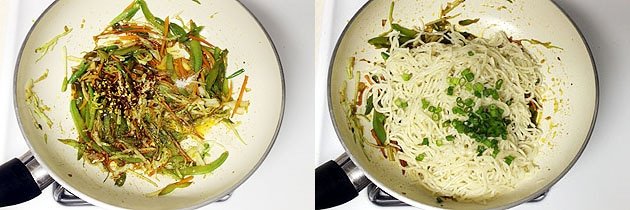
13) Toss the Noodles
Stir-fry everything over high heat for 1–2 minutes, allowing the noodles to warm up fully and absorb the flavors from the vegetables and sauces.
14) Finish with Vinegar
Finally, drizzle in the white vinegar, give it one last toss, and turn off the heat. Serve hot for the best taste and texture.
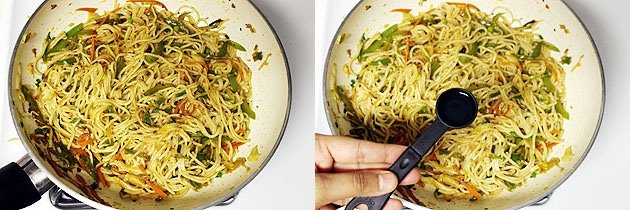
Serving Suggestions For Hakka Noodles:
- Veg Manchurian (Gravy): Soft, flavorful vegetable balls made from cabbage, carrots, and other finely chopped veggies are cooked until golden, then simmered in a thick, tangy, soy-based gravy. The rich and aromatic sauce, with hints of garlic, chili, and umami, coats each bite beautifully. When paired with veg Hakka noodles, it creates the ultimate comfort combo—spicy, savory, and deeply satisfying.
- Gobi Manchurian (Gravy): In this classic Indo-Chinese dish, cauliflower florets are lightly battered, fried until crisp, and then tossed in a spicy, sweet, and slightly sticky sauce infused with garlic, green chilies, and soy sauce. The bold flavors of gobi Manchurian contrast wonderfully with the mild noodles, making it a favorite pairing for those who love a bit of heat and crunch in their meal.
- Chilli Paneer (Gravy): This beloved dish features tender cubes of paneer (Indian cottage cheese) sautéed with bell peppers, onions, garlic, and green chilies in a hot and flavorful chili-garlic sauce. The silky gravy clings to the paneer, delivering a spicy and tangy punch in every mouthful. When enjoyed alongside veg Hakka noodles, it creates a rich, spicy, and protein-packed meal.
- Sweet Corn Soup or Hot & Sour Soup: Begin your Indo-Chinese spread with a warm bowl of soup. Sweet corn soup offers a gentle, slightly creamy flavor with sweet kernels and subtle seasoning, while hot & sour soup packs a tangy, spicy punch with vegetables, tofu, and bold seasoning. Either one sets the perfect tone for the flavorful meal ahead.
You can also serve Hakka noodles with:
- Spicy tofu stir-fry
- Indo-Chinese spring rolls
- Paneer chilli dry for a contrast in texture
Expert Tips for Perfect Veg Hakka Noodles
- Use the Right Noodles: Always opt for Hakka-style noodles or chow mein noodles that are meant for stir-frying. These are sturdier and hold their shape even after cooking and tossing with sauces.
- Don’t Overcook the Noodles: Boil only until al dente. Overcooked noodles will turn mushy when stir-fried. Once boiled, drain the noodles and rinse them under cold running water to halt further cooking and eliminate excess starch.
- Prep Ahead: Indo-Chinese cooking is fast. Chop all your veggies, measure the sauces, and have everything ready before turning on the heat.
- Stir-Fry on High Heat: A wok or large heavy-bottomed pan works best. Cook the vegetables on high heat so they stay vibrant, crisp, and retain their flavor.
- Use Sesame Oil for Authentic Flavor: A small amount of toasted sesame oil adds a deep, nutty aroma and brings the dish closer to restaurant-style noodles.
- Balance the Sauces: Don’t go overboard with soy or chili sauce. Start small—you can always adjust later. A perfect Hakka noodle dish balances salty, spicy, and tangy flavors.
- Toss, Don’t Stir: While combining the noodles with vegetables and sauces, toss gently instead of stirring vigorously to avoid breaking the noodles.
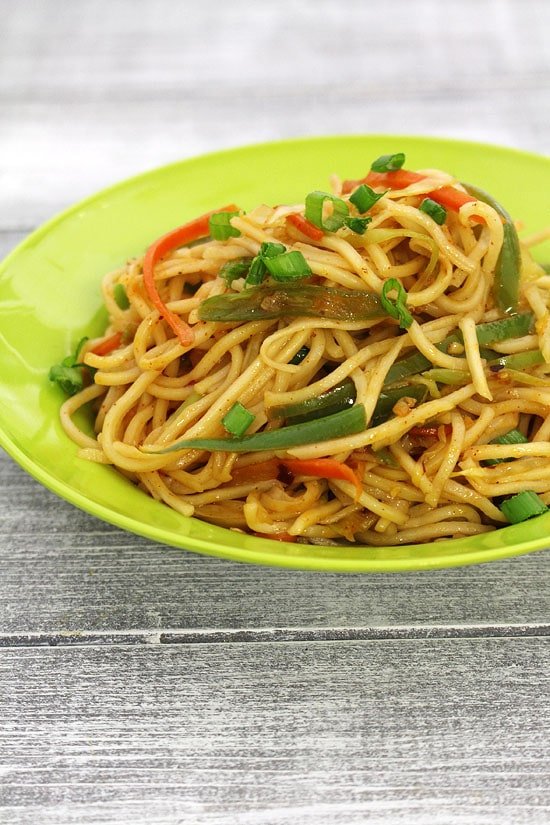
Variations You Can Try
1. Spicy Schezwan Noodles
For those who enjoy bold, fiery flavors, turn your classic Hakka noodles into Schezwan-style noodles by adding 1 to 2 tablespoons of Schezwan sauce. This vibrant red sauce infuses the dish with a smoky heat, a touch of sweetness, and deep chili-garlic undertones. It not only elevates the flavor profile but also gives the noodles a rich red hue. You can use store-bought sauce or make a fresh batch at home for maximum flavor.
2. Paneer Hakka Noodles
To make your meal more filling and protein-rich, add golden sautéed paneer cubes. Lightly pan-fry the paneer until crisp on the outside and soft inside, then toss it in toward the end of cooking. The paneer absorbs the sauces beautifully and adds a satisfying, melt-in-your-mouth texture. This variation is perfect for vegetarians looking to include more protein in their diet without compromising on taste.
3. Mushroom Noodles
For an umami-rich twist, include mushrooms in your veggie mix. Button mushrooms are most commonly used, but shiitake, oyster, or cremini mushrooms also work well. Sauté them until they release their moisture and start to brown, then stir them into your noodles. Their earthy flavor and meaty bite pair perfectly with the soy and garlic base of Hakka noodles.
4. Kids’ Friendly Version
If you’re making this dish for children or those who prefer mild flavors, tone down the spice by skipping the chili sauce and red chili flakes. Instead, add colorful, sweet vegetables like baby corn, sweet corn, or bell peppers to keep it vibrant and fun. You can even sneak in extra finely chopped veggies for added nutrition, all while keeping the flavors gentle and appealing to young taste buds.
5. High-Protein Power Noodles
For a healthier, protein-packed variation, stir in some scrambled tofu, pan-fried tempeh, or lightly sautéed soya chunks. These ingredients not only enhance the nutritional value of the dish but also make it more satisfying and ideal for a post-workout meal or a hearty vegetarian lunch. You can season the tofu or soya chunks with a pinch of salt, pepper, and garlic powder before adding them for an extra burst of flavor.
